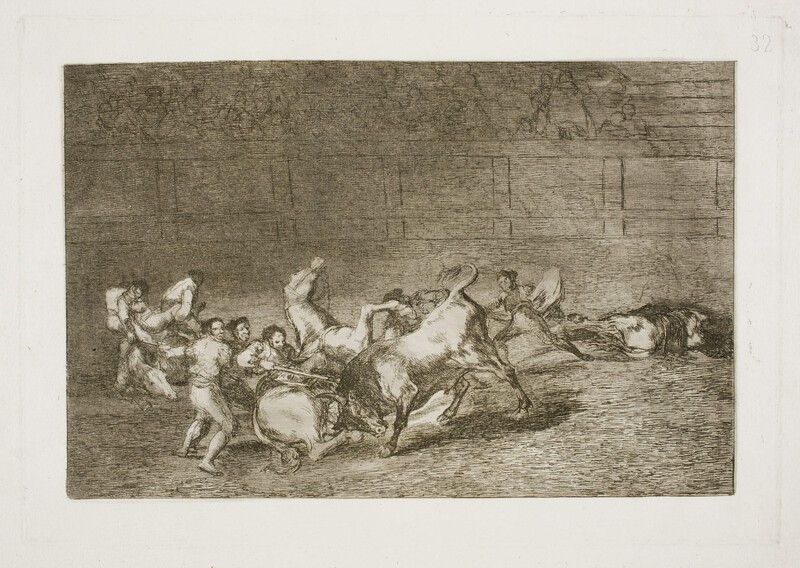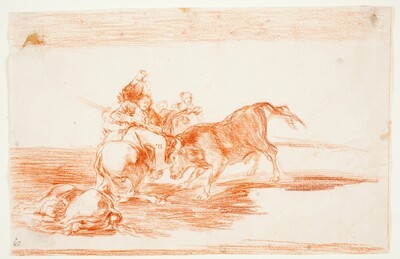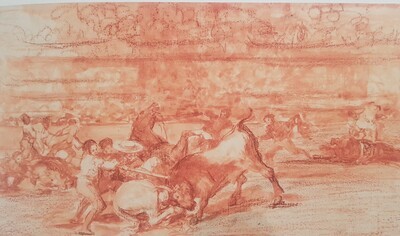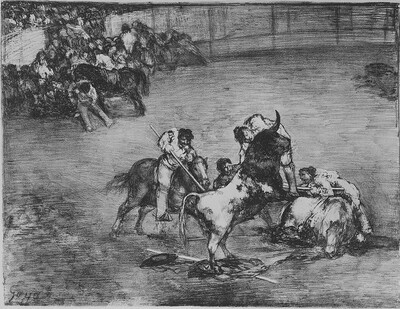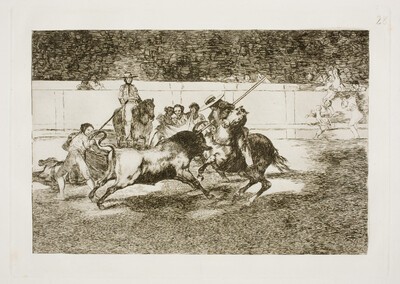- Cronología
- 1814 - 1816
- Dimensiones
- 245 x 354 mm
- Técnica y soporte
- Aguafuerte, aguatinta, punta seca, buril y bruñidor
- Reconocimiento de la autoría de Goya
- Documented work
- Ficha: realización/revisión
- 01 Oct 2021 / 22 Jun 2023
- Inventario
- -
- Otros títulos:
-
32 (print, upper right-hand corner)
See How the ancient Spaniards hunted bulls on horseback in the countryside
The plate is kept at the National Chalcography (nº 365).
See How the ancient Spaniards hunted bulls on horseback in the countryside
A fierce scene of fighting between several members of a cuadrilla and a bull, which has already caused the fall and death of two horses and has injured the picador riding one of them and is violently knocking down another horse in the foreground, including the picador who is riding it. In particular, we can see how the bull is thrusting a pitón into the horse's stomach while the picador, still on the horse, in turn thrusts his pike into the bull. There are several labourers in the arena, some of them removing the injured body of the fallen picador and others trying to separate the bull from the horse he is charging and to hold the picador who is about to fall, helping him to pike the bull.
The lighting of the scene is very dramatic because there is only light on the characters. The rest of the square, including the stretches of ground, is darkened. In this way, with these flashes of light, Goya directs our attention to where he wants us to look. However, in the two preparatory drawings for the print, the light is still spread throughout the scene.
For Bagüés this type of tumultuous scene reminds him of the Disasters of War, while for Lafuente Ferrari the print is one of the engravings that narrate incidents or incidents without historical precision and reflects a tragic feeling that would culminate in the series of the Bulls of Bordeaux, in lithographs such as Brave Bull. In his opinion, it also presents a treatment very similar to that of the so-called "unpublished" prints, i.e. those that were not included in the official edition of the Bullfighting.
Glendinning, as in the case of other prints in the series (nos. 18, 19, 24, 26, 28 and 31), interprets the distorted faces of some of the figures as a criticism of those who participate in one way or another in a bullfight. Martínez-Novillo, for his part, relates the engraving to the Bullfighting prints and their extensions that deal with the suerte de varas and its incidents (Nos. 22, 26, 27, 28 and 32, and B), such as the one entitled The hardworking Rendón stinging a bull, from whose luck he died in the bullring in Madrid.
As already mentioned, there are two preparatory drawings of the present print, also entitled Two groups of bullfighters run over by a single bull at once (preparatory drawing 1) and Two groups of bullfighters run over by a single bull at once (preparatory drawing 2)
-
Grabados y dibujos de Goya en la Biblioteca NacionalBiblioteca NacionalMadrid1946catalogue Elena Páez Ríos
-
Goya en la Biblioteca Nacional. Exposición de grabados y dibujos en el sesquicentenario de su muerteBiblioteca NacionalMadrid1978May - June 1978
-
Goya. Das Zeitalter der Revolucionen. Kunst um 1800 (1980 – 1981)Hamburger KunsthalleHamburg1980cat. 256
-
1984
-
Madrid1987
-
Goya: toros y torerosEspace Van GoghArles1990displayed also at Academia de Bellas Artes de San Fernando, Madrid, consultant editor Pierre Gassier.cat. 48
-
Goya grabadorFundación Juan MarchMadrid1994consultant editors Alfonso E. Pérez Sánchez and Julián Gállego, from January 14th to March 20th 1994
-
Goya grabadorMuseo del Grabado Español ContemporáneoMarbella1996from March 8th to May 5th 1996
-
Zaragoza1996
-
Schlaf der Vernunft. Original radierungen von Francisco de GoyaMunich2000
-
Madrid2002
-
Madrid2002
-
Goya en tiempos de guerraMuseo Nacional del PradoMadrid2008consultant editor Manuela B. Mena Marqués, from April 14th to July 13th 2008cat. 158
-
Bilbao2012
-
Goya et la modernitéPinacothèque de ParisParís2013from October 11st 2013 to March 16th 2014cat. 37
-
Zaragoza2017
-
ZaragozaTip. del Hospicio1926p. 37
-
1946pp. 177-216, espec. pp. 206-207
-
BarcelonaTartessos-F. Oliver Branchfelt1946 (reed. 1951)
-
1961pp. 120-127
-
OxfordBruno Cassirer1964vol. II, 1964, p. 348, cat. 235
-
Vie et ouvre de Francisco de GoyaParísOffice du livre1970p. 279, cat. 1214
-
The Changing image: Prints by Francisco GoyaBostonMuseum of Fine Arts1974pp. 241-243, cat. 193-195
-
Goya, Das Zeitalter de Revolutionen. 1789-1830HamburgPrestel-Verlag Münche und Hamburger Kunsthalle1980p. 293
-
MilwakeeMilwaukee Art Museum1986p. 27
-
Goya, toros y torerosMadridMinisterio de Cultura, Comunidad de Madrid1990p. 115
-
MadridCaser-Turner1992pp. 26 y 35
-
Catálogo de las estampas de Goya en la Biblioteca NacionalMadridMinisterio de Educación y Cultura, Biblioteca Nacional1996cat. 357
-
MadridMuseo Nacional del Prado2001pp. 95-97
-
MadridMuseo Nacional del Prado y Ediciones El Viso2008pp. 437-439, cat. 157-158
-
Goya en tiempos de guerraMadridMuseo Nacional del Prado2008p. 158
-
Goya. In the Norton Simon MuseumPasadenaNorton Simon Museum2016pp. 186-201
-
ParísPinacoteca de París2013p. 110
